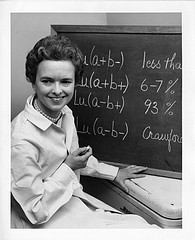HRDAG and the Digital Commons
One of the three main goals of HRDAG is education and outreach, and to that end we use Creative Commons licenses for all of our blogposts and, whenever possible, for our publications. Using a Creative Commons license makes it clear that educators are free to use HRDAG’s publications, in their entirety, and with the peace of mind that they are doing so with our blessing.
Also, the use of the Creative Commons license allows us to participate in and encourage the creation of a digital commons, which we feel helps to advance another one of our goals, the creation of knowledge. We feel that it’s important to offer up our publications for use and reuse by the many different groups that use them—truth commissions and prosecutors, human rights projects and organizations, educators, and researchers.
HRDAG has chosen the Unported Attribution Non-commercial Share Alike license, which you’ll see indicated on all of our blogposts and on certain publications as “BY-NC-SA.” The “unported” option means that the license isn’t based on one country’s laws, but rather that it is a license under “international” law. Using an unported license is very important, as people use HRDAG’s analysis all over the world. One recent example of international use include the recent trial in Guatemala of General Ríos Montt, in which the prosecutor used our analysis as evidence of genocide against indigenous peoples. Another example is the expert report that was used in the trial of former Yugoslav president Slobodan Milošević at the ICTY (International Criminal Tribunal for the Former Yugoslavia) in The Hague, for charges of war crimes.
Of course, we can’t apply Creative Commons licenses to all of our publications—papers published by traditional journals, for example, are subject to those journals’ copyright protocols. But when we have control or influence over the publication of analysis, we strive to make sure we can offer those publications with a CC license, and we make it as clear as possible which publications are available under the BY-NC-SA license. Naturally, journalists and researchers have always been free to cite and quote from our publications with proper attribution, so you might wonder what is gained by applying a CC license. We feel that a CC license makes it clear that reuse is encouraged, and that the publications may be reproduced and distributed in whole cloth, instead of in excerpts.
In academic settings, the use of a CC license means that educators all over the world can *know* that they are free to use those publications in their entirety, rather than being forced to use excerpts. Historically, all over the world, it has been the case that educators and academics were always been free to excerpt and quote, with proper attribution, from anything they wish. In the United States, these “Fair Use” Provisions were officially codified in Section 107 of the Copyright Act of 1976, which clearly states that: “the fair use of a copyrighted work, including such use by reproduction in copies … for purposes such as criticism, comment, news reporting, teaching (including multiple copies for classroom use), scholarship, or research, is not an infringement of copyright.” Using this criteria, one might think that making “multiple copies” for “teaching” is an obvious and straight forward interpretation of the law’s Fair Use provisions. However, in 1998, when the Digital Millennium Copyright Act (DMCA) was passed, the legality of fair use “digital copies” for educational uses was suddenly called into question. To make matters worse, the DMCA also makes it a crime to use simple technologies to engage one’s fair use rights. For instance, under the DMCA, if a teacher were to take a screen grab of a graph from one of our publications (for use within a class, and giving proper attribution), under the DMCA, this *could be* interpreted as a Digital Rights Management “circumvention measure” that comes complete with criminal penalties. Unfortunately, other countries around the world are taking the DMCA’s lead, and these issues have created enough doubt in the minds of educators to cause a chilling effect all over the world. We hope that by applying the Creative Commons license to certain publications we can reverse the chilling trend.
One more note on the Creative Commons license: It’s important to remember that the HRDAG’s publications are available under this license, and not the underlying datasets used for analysis in the publications—although, whenever possible, we publish summary versions of our datasets so that other scholars can reproduce our results while the raw data remains confidential. (The datasets we use are often protected to maintain anonymity and confidentiality; another reason we do not offer unrestricted access to datasets is that they are vulnerable to being taken out of context by people and organizations that could be misled by the raw data. Patrick Ball wrote about this here). Further, HRDAG happily publishes estimates, that is, tables that contain finely-grained estimates of totals for specific time-space points. As an example, you may visit this page about our work in Casanare, Colombia.
Here’s where you can learn more about Creative Commons Licenses in general, and learn about some of the pros and cons of some of the more basic licenses, so you can then use CC’s licensing application to choose a license for your own creations.
Lisa Rein is a co-founder of Creative Commons.
Photo: Smithsonian Institution.
[Creative Commons BY-NC-SA]
